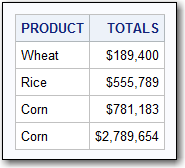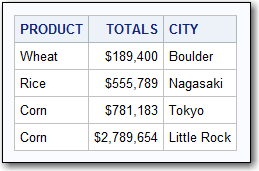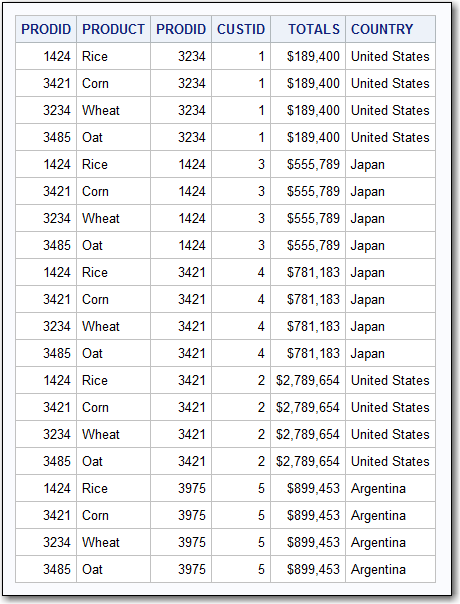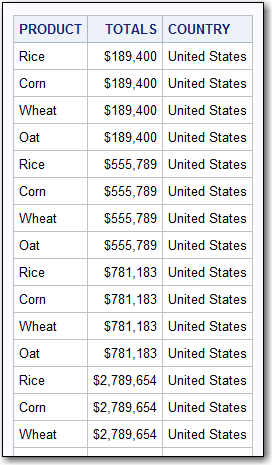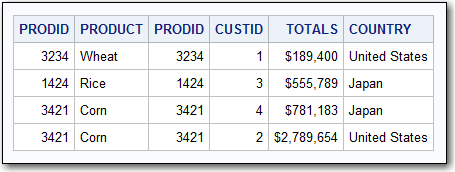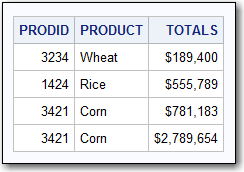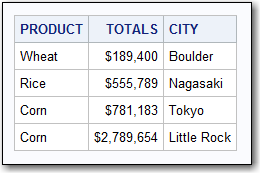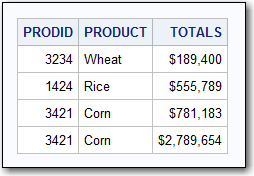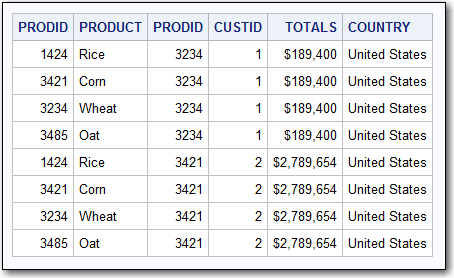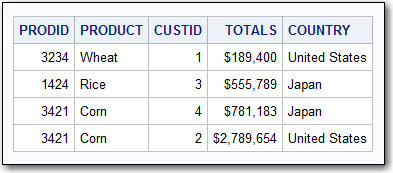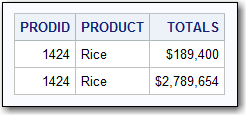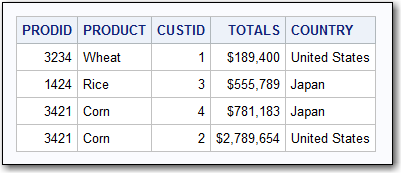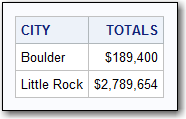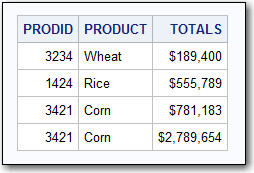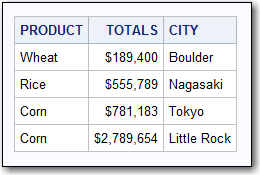Join Operations
Overview of Join Operations
A join operation is
a query that combines data from two or more tables or views based
usually on relationships among the data in those tables. When multiple
table specifications are listed in the FROM clause of a SELECT statement,
they are processed to form one result set. The result set contains
data from each contributing table and can be saved as a table or used
as is. Most join operations contain at least one join condition, which
is either in the FROM clause or in a WHERE clause.
For example, you can
join the data of two tables based on the values of a column that exists
in both tables. The following query joins the two tables Products
and Sales. FedSQL creates the result set by retrieving the data for
columns Product and Totals where the values match for the column Prodid.
select products.product, sales.totals from products, sales where products.prodid=sales.prodid;
Most joins are of two
tables. However, you can join more than two tables. To perform a join
operation of three or more tables, FedSQL first joins two tables based
on the join condition. Then FedSQL joins the results to another table
based on the join condition. This process continues until all tables
are joined into the result set. The following query first joins tables
Products and Sales, which produces a result set, and then joins the
result set and the table Customers, which produces the final result
set.
select products.product, sales.totals, customers.city from products, sales, customers where products.prodid=sales.prodid and sales.custid=customers.custid;
FedSQL supports several
join operations such as simple joins, equijoins, cross joins, qualified
joins, and natural joins. Appropriate syntax determines the type of
join operation. In addition, the qualified and natural join operations
can be affected by specifying the join type, which can be an inner
join or an outer join.
Note: The join operation examples
in this section use the tables Customers, Products, and Sales. To
view the tables, see Tables Used in Examples.
Understanding the Join Operations
Simple Join
A simple join is the
most basic type of join where multiple tables, separated by commas,
are listed in the FROM clause of a SELECT statement. There is no join
condition. Joining tables in this way produces a result set where
each row from the first table is combined with each row of the second
table, and so on.
This simple join example
selects all columns and all rows from the tables Products and Sales.
select * from products, sales;
This example is also
a simple join, but the SELECT statement specifies one column from
each of three tables. Each row from the first table is combined with
each row from the second table, which are then combined with each
row from the third table. The result is a large, basically meaningless
result set. The following output shows only a portion of the result
set.
select products.product, sales.totals, customers.country from products, sales, customers;
Equijoin
An equijoin is a simple
join that is subset with a WHERE clause. The join condition must be
an equality comparison. An equijoin produces a more meaningful result
than just a simple join, because only rows meeting the equality test
are returned. Multiple match criteria can be specified by using the
AND operator. When multiple match criteria are specified, only rows
that meet all of the equality tests are returned.
This equijoin example
selects all columns from the tables Products and Sales where the values
match for the column Prodid, which exists in both tables. Because
all columns are selected with the * notation, the Prodid column is
duplicated in the result set.
select * from products, sales where products.prodid=sales.prodid;
When you specify the
columns Prodid, Product, and Totals in the SELECT statement, the column
Prodid is not duplicated, even though it exists in both the Products
and Sales tables. The result set includes the data where the values
match for the column Prodid.
select products.prodid, products.product, sales.totals from products, sales where products.prodid=sales.prodid;
This equijoin example
selects the columns Product, Totals, and City from the tables Products,
Sales, and Customers. First, the result set includes the data where
the values match for the column Prodid, which exists in tables Products
and Sales. Then the result set is combined with the data where the
values match for the column Custid, which exists in tables Sales and
Customers.
select products.product, sales.totals, customers.city from products, sales, customers where products.prodid=sales.prodid and sales.custid=customers.custid;
Cross Join
A cross join is a relational
join that results in a Cartesian product of two tables. A cross join
is requested with the syntax CROSS JOIN. A cross join can be subset
with a WHERE clause, but you cannot use an ON clause.
This cross join example
selects all columns and all rows from the tables Products and Sales,
which produces the same results as a simple join of two tables.
select * from products cross join sales;This cross join example
selects the columns Prodid, Product, and Totals from tables Products
and Sales. The result set includes the data where the values match
for the column Prodid. The results are the same as an equijoin of
two tables.
select products.prodid, products.product, sales.totals
from products cross join sales
where products.prodid=sales.prodid;Qualified Join
A qualified join provides
an easy way to control which rows appear in the result set. You can
use any columns to match rows from one table against those from another
table. A qualified join is requested with the syntax JOIN and then
the syntax ON or USING to specify the join condition. You can use
a WHERE clause to further subset the query results.
-
The ON clause specifies a join condition to filter the data. The ON clause accepts search conditions such as conditional expressions like the WHERE clause. The ON clause joins tables where the column names do not match in both tables. For columns that exist in both tables, the ON clause preserves the columns from each joined table separately in the result set.
-
The USING clause specifies columns to test for equality. The columns listed in the USING clause must be present in both tables. The USING clause is like a shorthand way of defining join conditions without having to specify a qualifier. The USING clause is equivalent to a join condition where each column from the left table is compared to a column with the same name in the right table. For columns that exist in both tables, the USING clause merges the columns from the joined tables into a single column.
A qualified join can
be an inner join or an outer join, which is requested with the syntax
INNER or OUTER. If the join type specification is omitted, then an
inner join is implied. See Inner and Outer Join Types.
This qualified join
example selects all columns from the tables Products and Sales. The
returned rows are filtered based on the column Country in the Sales
table, where the value in Country equals United States. The column
Prodid exists in both tables and is duplicated in the result set.
select * from products join sales on (sales.country='United States');
This qualified join
example selects all columns from the tables Products and Sales. The
returned rows are filtered by selecting the values that match for
the column Prodid, which exists in both tables. The USING clause is
like a shorthand way of defining join conditions without having to
specify a qualifier. The USING clause is equivalent to a join condition
where each column from the left table is compared to a column with
the same name in the right table. Unlike an equijoin and a cross join,
the column Prodid is not duplicated in the result set.
select * from products join sales using (prodid);
This qualified join
example selects columns Prodid, Product, and Totals from the tables
Products and Sales. The returned rows are filtered based on the column
Country where the value equals United States. The returned rows are
further subset where the value for Product equals Rice.
select products.prodid, products.product, sales.totals from products join sales on (sales.country='United States') where products.product='Rice';
Natural Join
A natural join selects
rows from two tables that have equal values in columns that share
the same name and the same type. A natural join is requested with
the syntax NATURAL JOIN. If like columns are not found, then a cross
join is performed. Do not use an ON clause with a natural join. When
using a natural join, an ON clause is implied, matching all like columns.
You can use a WHERE clause to subset the query results. A natural
join functions the same as a qualified join with the USING clause.
A natural join is a shorthand of USING. Like USING, like columns appear
only once in the result set.
A natural join can be
an inner join or an outer join, which is requested with the syntax
INNER or OUTER. If the join type specification is omitted, then an
inner join is implied. See Inner and Outer Join Types.
This natural join example
selects all columns from the tables Products and Sales. The result
set includes the data where the values match for the column Prodid,
which exists in both tables. Unlike a cross join and a simple join
of two tables, the natural join result set does not include duplicate
Prodid columns.
select * from products natural join sales;This natural join example
selects columns City and Totals from the tables Sales and Customers.
The result set includes the data where the values match for the columns
Custid and Country, which exist in both tables. The returned rows
are subset where the value for Country equals United States.
select customers.city, sales.totals
from sales natural join customers
where customers.country='United States';Inner and Outer Join Types
Inner Joins
An inner join returns
a result set that includes all rows from the first table that matches
rows from the second table. Inner joins return only those rows that
satisfy the join condition. Unmatched rows from both tables are discarded.
By default, qualified joins and natural joins function as inner joins.
Including the syntax INNER has no additional effects on the result
set.
select * from products inner join sales
on (sales.country='United States');select customers.city, sales.totals
from sales natural inner join customers
where country='United States';Outer Joins
An outer join returns
a result set that includes all rows that satisfy the join condition
as well as unmatched rows from one or both tables. An outer join can
be a left, right, or full outer join. An inner join discards any rows
where the join condition is not met, but an outer joins maintains
some or all of the unmatched rows.
For an outer join, a
specified WHERE clause is applied after the join is performed and
eliminates all rows that do not satisfy the WHERE clause. Applying
a WHERE clause to an outer join can sometimes defeat the purpose,
because the WHERE clause deletes the very rows that the outer join
retains.
-
A left outer join preserves unmatched rows from the left table, which is the first table listed in the SELECT statement. A left outer join returns a result set that includes all rows that satisfy the join condition and rows from the left table that do not match the join condition. Therefore, a left outer join returns all rows from the left table, and only the matching rows from the right table. A left outer join is requested with the syntax LEFT [OUTER].This qualified join example returns a result set that includes all rows from both tables that satisfy the join condition. The join condition filters rows based on the column Country where the value equals United States. The result set also includes rows from the Customers table that do not match the join condition. As a left outer join, all rows from the Customers table are returned.
select customers.city, sales.totals from customers left outer join sales on (customers.country='United States');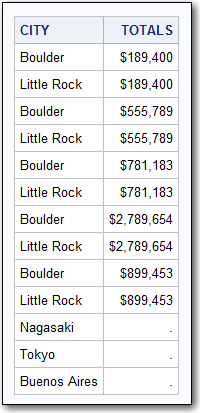 This natural join example returns a result set that includes all rows from both tables that satisfy the join condition, which includes the data where the values match for the column Prodid The result set also includes a row from the Sales table that does not match the join condition. As a left outer join, all rows from the Sales table are returned.
This natural join example returns a result set that includes all rows from both tables that satisfy the join condition, which includes the data where the values match for the column Prodid The result set also includes a row from the Sales table that does not match the join condition. As a left outer join, all rows from the Sales table are returned.select * from sales natural left outer join products;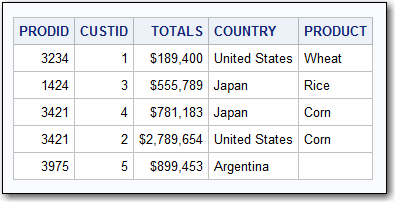
-
A right outer join preserves unmatched rows from the right table, which is the second table listed in the SELECT statement. A right outer join returns a result set that includes all rows that satisfy the join condition and rows from the right table that do not match the join condition. Therefore, a right outer join returns all rows from the right table, and only the matching rows from the left table. A right outer join is requested with the syntax RIGHT [OUTER].This qualified join example returns a result set that includes all rows from both tables that satisfy the join condition. The join condition filters rows based on the column Country where the value equals United States. The result set also includes rows from the Sales table that do not match the join condition. As a right outer join, all rows from the Sales table are returned.
select * from products right outer join sales on (sales.country='United States');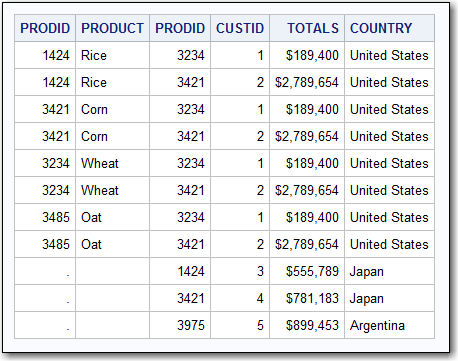 This natural join example returns a result set that includes all rows from both tables that satisfy the join condition, which includes the data where the values match for the column Prodid. The result set also includes a row from the Sales table that does not match the join condition. As a right outer join, all rows from the Sales table are returned.
This natural join example returns a result set that includes all rows from both tables that satisfy the join condition, which includes the data where the values match for the column Prodid. The result set also includes a row from the Sales table that does not match the join condition. As a right outer join, all rows from the Sales table are returned.select * from products natural right outer join sales;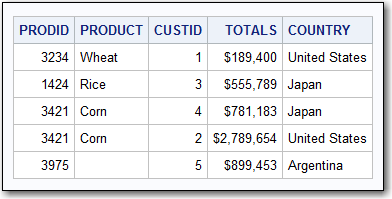
-
A full outer join preserves unmatched rows from both tables. That is, a full outer join returns all matching and unmatching rows from the left and right table. A full outer join is requested with the syntax FULL [OUTER].This qualified join example returns a result set that includes all rows from both tables that satisfy the join condition. The join condition filters rows based on the column Product containing the value Rice. The result set also includes all rows from both tables that do not match the join condition. As a full outer join, all rows from both tables are returned.
select * from products full outer join sales on (products.product='Rice');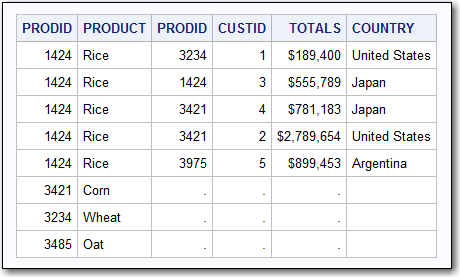 This natural join example returns a result set that includes all rows from both tables that satisfy the join condition, which includes the data where the values match for the column Prodid. The result set also includes a row from the Sales table and a row from the Products table that does not match the join condition. As a full outer join, all rows from both tables are returned.
This natural join example returns a result set that includes all rows from both tables that satisfy the join condition, which includes the data where the values match for the column Prodid. The result set also includes a row from the Sales table and a row from the Products table that does not match the join condition. As a full outer join, all rows from both tables are returned.select * from products natural full outer join sales;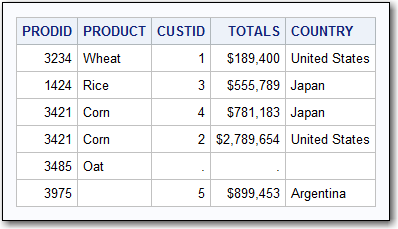
Joining Heterogeneous Data
Because typical organizations
store data in multiple databases, FedSQL supports joining heterogeneous
data. A heterogeneous join occurs when the tables in a join operation
exist on different data sources. A heterogeneous join is one type
of a federated query.
All FedSQL join operations
can be performed as heterogeneous joins. For example, the following
natural join is a heterogeneous join between an Oracle table and a
Teradata table.
select * from oracle.product natural left outer join tera.sales;
This heterogeneous join
example queries both a SAS data set and an Oracle table. PROC FEDSQL
uses the attributes of the librefs to connect to the two data sources.
The SAS data set MyBase.Products contains the columns Prodid and Product.
The Oracle table Oracle.Sales contains the columns Prodid, Totals,
and Country. The SELECT statement joins the columns and rows from
both tables based on the column Prodid, which exists in both tables.
libname mybase base 'C:\Base';
libname myoracle oracle user=scott password=tiger path=oraclev11;
proc fedsql;
select mybase.products.prodid, mybase.products.product, myoracle.sales.totals
from mybase.products, myoracle.sales
where products.prodid=sales.prodid;
quit;This heterogeneous join
example queries three tables: two Oracle tables and one SAS data set.
In the query, the join of MyOracle.Products and MyOracle.Customers
is performed by Oracle. The join of the Oracle result set with the
SAS data set MyBase.Sales is performed by FedSQL.
libname mybase base 'C:\Base';
libname myoracle oracle user=scott password=tiger path=oraclev11;
proc fedsql;
select myoracle.products.product, mybase.sales.totals, myoracle.customers.city
from myoracle.products, mybase.sales, myoracle.customers
where products.prodid=sales.prodid and sales.custid=customers.custid;
quit;Copyright © SAS Institute Inc. All rights reserved.
